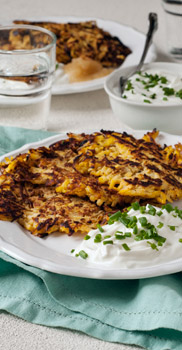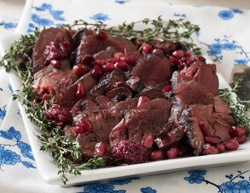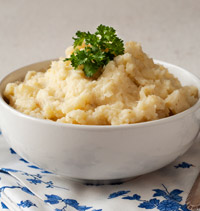On the Wild Side
A Paleo feast takes a walk in the wild
For those of you who eat Paleo/Primal, I’m sure you’ve gotten a reaction like this one from friends and family (likely with the air quotes added in for good measure): “Oh, that ‘caveman’ thing? Do you, like, eat raw meat and forage for nuts and berries?”
While the joke gets old, there is some truth and wisdom to it. No, you won’t find me gnawing on a cow in a pasture or eating wild berries on my trail runs (with my luck, I’d pick the wrong kind, keel over dead, and be a tasty meal for the woodland creatures). However, there is something to this way of eating that may open you up to trying foods that you never thought you would.
Believe it or not, you can “forage” in your own grocery store or farmers’ market for new ingredients to try like an exotic fruit, a crazy looking root vegetable, or a wild mushroom. In the Midwest where I currently live, people go nuts for mushrooms called morels. Wild and hunted, they’re often sold for upwards of $30 a pint. People guard their hunting grounds like the map to the Holy Grail and when you taste one, you’ll know why. I never liked mushrooms until I tried one of these brainy looking little guys. Sweet and delicate, they’re proof that either your taste buds can change or they’re so good they changed them for me. So I guess in this case, if you live in an area where they’re prominent during the spring season (late April through early June), you could technically be foraging for your food. Take that, caveman.
If you don’t live in a place where you can safely hunt for mushrooms, I still encourage you to channel your inner caveman and give things that may look a little scary a try. This can extend beyond the produce department and into your local meat market or meat section of your farmers’ market. This gives you the chance to open up a dialogue with your farmer: ask him how the meat was raised, what the best cut is, and how to cook it. You’ll create a relationship with the person who helped raise and cultivate your food and you’ll likely learn something new!
In this article, I want to give you the tools (and maybe the push you need) to feast on the wild side while in our modern age. I have chosen root vegetables, tubers, mush- rooms, and venison—some of which you may never have seen before—to create this meal. From appetizer to side dish, you’ll be able to tell those joking friends that you can be a civilized caveman, or even invite them over to try for themselves.
 Rutabaga Latkes
Rutabaga Latkes
(Gluten-free, Grain-free, Dairy-free, Nut-free, Soy-free, Refined Sugar-free, Vegetarian)
I didn’t have my first rutabaga until I was 30 for no other reason than I really had no idea what to do with it. But when one showed up in my CSA box, I knew I had to figure it out. I do not waste food. It makes me insane to throw anything away. Though these latkes are savory, try topping them with pan-fried apple slices to bring a little sweetness to the dish and offset the spice of the turnip.
Makes 12-15 latkes
4 cups peeled and shredded rutabagas
3 cups peeled and shredded turnips
1½ cups cooked and mashed butternut squash
3 eggs, beaten
1 tablespoon garlic powder
1 tablespoon onion powder
2 teaspoons dried rosemary
1 teaspoon dried sage
1 teaspoon sea salt
Grapeseed oil, for frying
Using a flour sack kitchen towel, squeeze out any extra water from the shredded turnips and rutabagas. Add all of the ingredients except the oil to a large bowl and mix and mash. (Using your hands is the easiest!)
Heat 2-3 tablespoons of oil in a skillet over medium heat. Add approximately ¼ cup of mixture to the skillet for each latke. Depending on the size of your skillet, limit the amount of latkes cooking so you don’t lower the heat of the oil. This will cause uneven cooking and burning. Cook latkes for 1-2 minutes on each side until golden brown. Place on a wire rack to cool and drain. Cook remaining latkes, adding more oil as needed.
Serve the latkes topped with apple slices sautéed in butter or ghee, unsweetened applesauce, or – if you tolerate dairy – full-fat sour cream and chives.
 Venison Filets with Pomegranate Blackberry Mushroom Sauce
Venison Filets with Pomegranate Blackberry Mushroom Sauce
(Gluten-free, Grain-free, Egg-free, Nut-free, Soy-free, Refined Sugar-free)
Tracy, my hunter friend, gave me a bag of venison filets recently and they were honestly one of the best cuts of meat I have ever tasted! They weren’t gamey, but instead tasted tender, rich, and delicious. Soaking them in red wine for a few hours prior to cooking helps to tenderize them while adding flavor as well. These filets cook very quickly and should be served medium to medium rare.
Serves 4
4 (4-ounce) venison filets
2 cups red wine
6 tablespoons butter, divided use
1 cup fresh pomegranate seeds
1 cup blackberries
1 pint mushrooms, sliced
2 tablespoons honey
½ teaspoon apple cider vinegar
1 teaspoon dried thyme
1 teaspoon dried sage
1 teaspoon dried rosemary
Pinch of salt
Soak the filets in red wine in the refrigerator for a few hours prior to cooking or even overnight. Preheat the oven to 375ºF.
In a large oven-safe skillet set over high heat, melt 2 tablespoons of the butter. Quickly sear the filets on both sides, about 10-20 seconds per side. Transfer the pan to the oven and cook for 5 minutes for rare, 6-7 minutes for medium, and 7-8 minutes for medium well. Slice thin to serve.
While the meat cooks, make the sauce. Add the remaining 4 tablespoons butter, pomegranate seeds, blackberries, mushrooms, honey, vinegar, herbs, and salt to a saucepan. Bring to a boil then reduce to a simmer. Cook for 10-15 minutes.
Divide the mixture in half. Blend one half to yield a puree. (A handheld immersion blender works great for this.) Strain through a fine mesh strainer. Spoon the puree on top of the sliced venison. Top with the reserved unblended sauce.
If you find cooking with pomegranates daunting, use this simple trick: Score the pomegranate around the center and pry open. Take each half and loosen by pulling and stretching. Turn upside down in your hand over a bowl, and hit the pomegranate with a wooden spoon. The seeds simply fall right out!
Roasted Garlic Mashed Parsnips
(Gluten-free, Grain-free, Egg-free, Soy-free, Refined Sugar-free, Vegetarian)
Many people who eat Paleo/Primal get stuck in the rut of making mashed cauliflower, leaving the poor parsnip behind. But parsnips actually have a very similar consistency to mashed potatoes. The roasted garlic melds with the peppery flavor of the parsnips to create a creamy side dish that even the kids eat!
Serves 4
1 pound parsnips, peeled and diced
½ cup unsweetened almond milk
1 head roasted garlic (see below)
1 teaspoon dried parsley
2 tablespoons butter or ghee
Salt and pepper, to taste
Bring a medium saucepan of water to boil. Add the diced parsnips and cook for approximately 10 minutes or until soft. Drain. Add to a bowl with the remaining ingredients and mash to reach the desired consistency.
To roast garlic: Slice off the top ¼ inch of the entire bulb of garlic. Drizzle some olive oil on top, sprinkle with a pinch of sea salt, wrap in aluminum foil, and roast in the oven at 400ºF for 30-35 minutes. Let cool, then squeeze out the soft garlic cloves.
Written by AndreAnna McLean
Have you tried this recipe? Give it a star rating and let us know your thoughts in the Ratings & Reviews section below.



